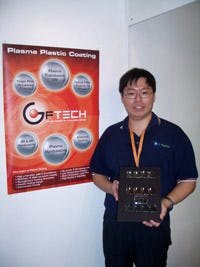GF Technology's Khor: His firm's cost-effective ceramic coating relies on plasma. Processors in Southeast Asia have been coming under increased cost pressures both through competition from China and high raw materials costs but they are fighting back through a mix of innovation and automation.
September 29, 2008
|
Processors in Southeast Asia have been coming under increased cost pressures both through competition from China and high raw materials costs but they are fighting back through a mix of innovation and automation.
Take Malaysian injection molder GF Technology (Penang), for instance, exhibiting its silica plasma coating technology for plastic substrates at the recent Aseanplas show in Singapore. The process is used as a cost competitive alternative to the conventional three-step process of primer, vacuum metallization, and UV-cured clear coat. Khor Meow Siang, GF Technology's managing director, says, “Besides aesthetic coatings, various functionalities such as infrared shielding, EMI shielding, microwave shielding and birefringence reduction can be formed.” A microwave shielding application is already commercial in the form of a microwave detector sold by Agilent. Mobile phone manufacturers such as Motorola are also employing the services of GF Technology to mold and coat cellphone covers.
Processors there are signaled they were transitioning from a reliance on manual labor to a greater adoption of automation. “Before processors took advantage of low labor costs but that's no longer the case. The idea now is to try and recover investment as soon as possible, and energy savings and maximizing output are the keys,” says Lee Chee Kiong, general manager of injection and extrusion for Asia Pacific at auxiliary equipment supplier and Aseanplas exhibitor Piovan Asia (Singapore). In the region, Piovan recently supplied a feeding, blending and dosing system for a PET sheet line for electronic packaging, as well as one for a PET strapping line. Lee notes that skilled labor is hard to come by in ASEAN and processors are trying to take out the labor variables. “Processors also don't want to manually handle bags of material if they can help it. The PET sheet line uses a day storage bin.”
You May Also Like



